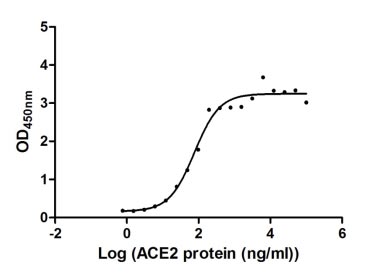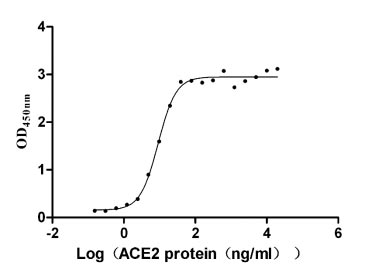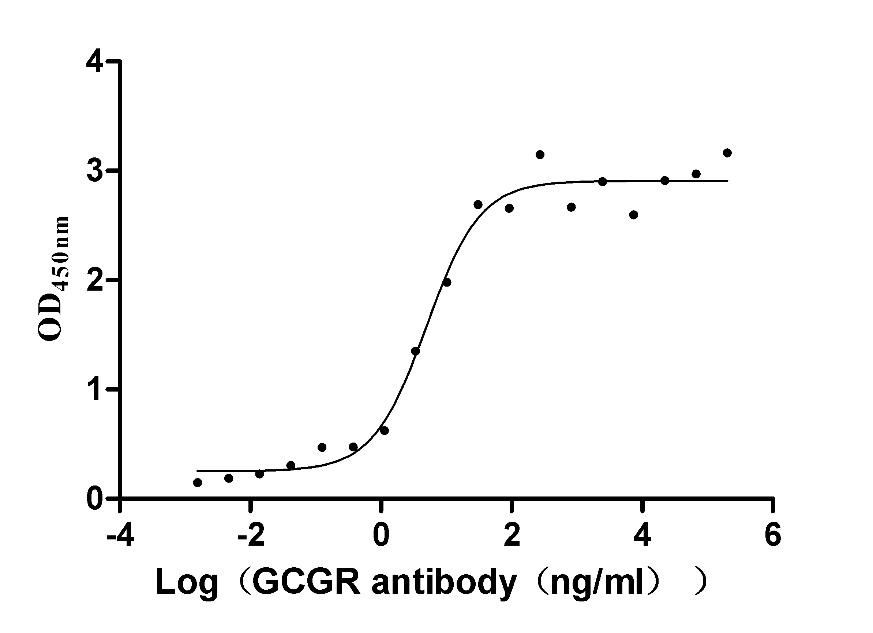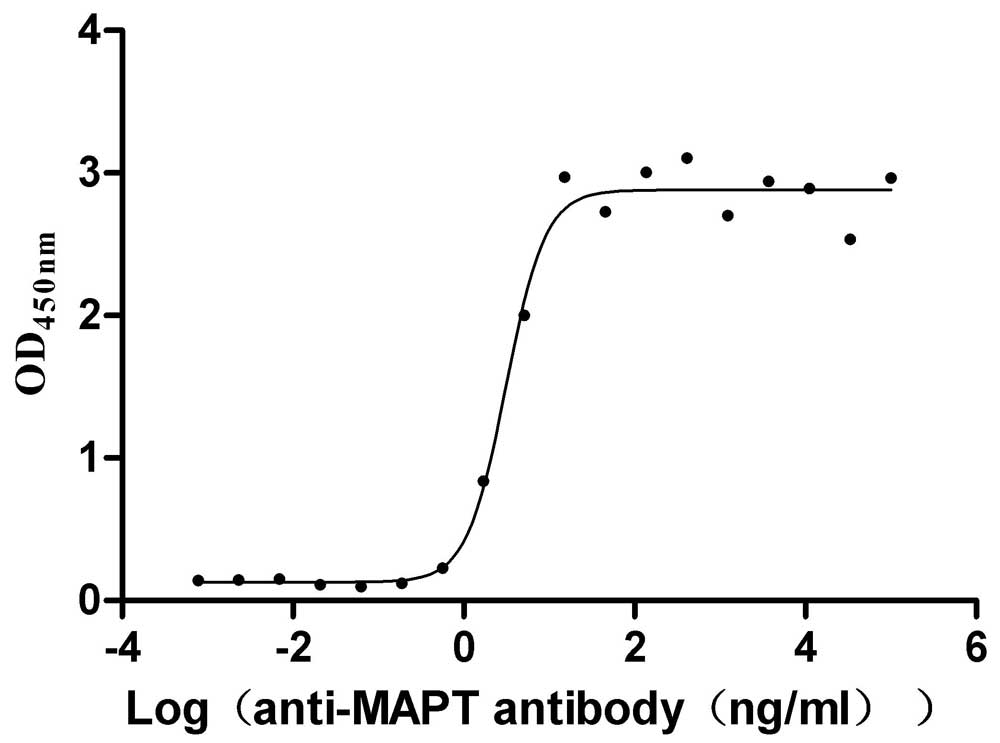Recombinant Rat Myogenin (Myog)
-
中文名称:大鼠Myog重组蛋白
-
货号:CSB-YP015360RA
-
规格:
-
来源:Yeast
-
其他:
-
中文名称:大鼠Myog重组蛋白
-
货号:CSB-EP015360RA
-
规格:
-
来源:E.coli
-
其他:
-
中文名称:大鼠Myog重组蛋白
-
货号:CSB-EP015360RA-B
-
规格:
-
来源:E.coli
-
共轭:Avi-tag Biotinylated
E. coli biotin ligase (BirA) is highly specific in covalently attaching biotin to the 15 amino acid AviTag peptide. This recombinant protein was biotinylated in vivo by AviTag-BirA technology, which method is BriA catalyzes amide linkage between the biotin and the specific lysine of the AviTag.
-
其他:
-
中文名称:大鼠Myog重组蛋白
-
货号:CSB-BP015360RA
-
规格:
-
来源:Baculovirus
-
其他:
-
中文名称:大鼠Myog重组蛋白
-
货号:CSB-MP015360RA
-
规格:
-
来源:Mammalian cell
-
其他:
产品详情
-
纯度:>85% (SDS-PAGE)
-
基因名:Myog
-
Uniprot No.:
-
别名:Myog; Myogenin
-
种属:Rattus norvegicus (Rat)
-
蛋白长度:Full length protein
-
表达区域:1-287
-
氨基酸序列MELYETSPYF YQEPHFYDGE NYLPVHLQGF EPPGYERTEL SLSPEARGPL EEKGLGTPEH CPGQCLPWAC KVCKRKSVSV DRRRAATLRE KRRLKKVNEA FEALKRSTLL NPNQRLPKVE ILRSAIQYIE RLQALLSSLN QEERDLRYRG GGGPSRWYPV NATPTAPPAV RSGAMHWSLV PTQEIICSQL TLQVPTTCTP LRPSWTASRW RICLSPSQMK PCPTEIVCQA GCAWEPLSWC QTPPLLQQGP FKWGCPGAQK TALGCHKPDY PPSIHIRLTP SPAREFN
-
蛋白标签:Tag type will be determined during the manufacturing process.
The tag type will be determined during production process. If you have specified tag type, please tell us and we will develop the specified tag preferentially. -
产品提供形式:Lyophilized powder
Note: We will preferentially ship the format that we have in stock, however, if you have any special requirement for the format, please remark your requirement when placing the order, we will prepare according to your demand. -
复溶:We recommend that this vial be briefly centrifuged prior to opening to bring the contents to the bottom. Please reconstitute protein in deionized sterile water to a concentration of 0.1-1.0 mg/mL.We recommend to add 5-50% of glycerol (final concentration) and aliquot for long-term storage at -20℃/-80℃. Our default final concentration of glycerol is 50%. Customers could use it as reference.
-
储存条件:Store at -20°C/-80°C upon receipt, aliquoting is necessary for mutiple use. Avoid repeated freeze-thaw cycles.
-
保质期:The shelf life is related to many factors, storage state, buffer ingredients, storage temperature and the stability of the protein itself.
Generally, the shelf life of liquid form is 6 months at -20°C/-80°C. The shelf life of lyophilized form is 12 months at -20°C/-80°C. -
货期:Delivery time may differ from different purchasing way or location, please kindly consult your local distributors for specific delivery time.Note: All of our proteins are default shipped with normal blue ice packs, if you request to ship with dry ice, please communicate with us in advance and extra fees will be charged.
-
注意事项:Repeated freezing and thawing is not recommended. Store working aliquots at 4°C for up to one week.
-
Datasheet :Please contact us to get it.
靶点详情
-
功能:Acts as a transcriptional activator that promotes transcription of muscle-specific target genes and plays a role in muscle differentiation, cell cycle exit and muscle atrophy. Essential for the development of functional embryonic skeletal fiber muscle differentiation. However is dispensable for postnatal skeletal muscle growth; phosphorylation by CAMK2G inhibits its transcriptional activity in respons to muscle activity. Required for the recruitment of the FACT complex to muscle-specific promoter regions, thus promoting gene expression initiation. During terminal myoblast differentiation, plays a role as a strong activator of transcription at loci with an open chromatin structure previously initiated by MYOD1. Together with MYF5 and MYOD1, co-occupies muscle-specific gene promoter core regions during myogenesis. Cooperates also with myocyte-specific enhancer factor MEF2D and BRG1-dependent recruitment of SWI/SNF chromatin-remodeling enzymes to alter chromatin structure at myogenic late gene promoters. Facilitates cell cycle exit during terminal muscle differentiation through the up-regulation of miR-20a expression, which in turn represses genes involved in cell cycle progression. Binds to the E-box containing (E1) promoter region of the miR-20a gene. Plays also a role in preventing reversal of muscle cell differentiation. Contributes to the atrophy-related gene expression in adult denervated muscles. Induces fibroblasts to differentiate into myoblasts.
-
基因功能参考文献:
- low-level laser therapy (LLLT) administered following muscle injury modulates the mRNA expression of MyoD and myogenin. Moreover, the both forms of LLLT administration were able to modulate the mRNA expression of IL-6 during the muscle repair process. PMID: 26914683
- Suggest that myogenin is the target for doxorubicin-induced cardio-toxicity. PMID: 26452256
- Myogenin, which is expressed in MPCs, belongs to a family of basic helix-loop-helix transcription factors that activate skeletal muscle differentiation and thus plays a key role in fetal diaphragmatic development and muscularization. PMID: 25056796
- Myogenin, myostatin, and follistatin expression is lower and MRF4 levels higher in spontaneously hypertensive rats (SHR) PMID: 22464481
- Sema3A is a crucial factor that is up-stream of the muscle-specific transcription factor, myogenin. PMID: 23085379
- Expression of Myod and myogenin is increased in skeletal muscle of rats fed magnesium-deficient diet. PMID: 21858842
- Results describe the involvement of myogenin and GATA4, two tissue-specific transcription factors, and the atrial natriuretic factor promoter, in cardiac transcriptional activity. PMID: 20384792
- Myogenin gene expression in developing plantaris and soleus muscles was significantly reduced (P < 0.001) in microgravity PMID: 11960943
- Antisense inhibition of myoD expression in regenerating rat soleus muscle is followed by an increase in the mRNA levels of myoD, myf-5 and myogenin and by a retarded regeneration. PMID: 12063168
- To study the changes of MyoD/myogenin expression in atrophic muscle after injury of brachial plexus among rats and to explore the role of proteins of MyoD family in denervation-induced muscular atrophy. PMID: 12133506
- increased expression of myogenin mRNA in skeletal muscles was observed after repetitive stretch for 4 hours PMID: 12638111
- A rapid increase in myogenin mRNA and protein is observed in denervated and spinal cord isolated muscles--a widespread expression that is observable in myonuclei and satellite cells. PMID: 12839833
- these data are consistent with the hypothesis that myogenin is in the pathway for exercise-induced changes in mitochondrial enzymes PMID: 15033961
- even in the presence of phosphorylated Akt, it is only when ERK1/2 phosphorylation is inhibited that IGF-I can stimulate myogenin mRNA expression. PMID: 15489316
- The mechanical ventilation-induced reduction in diaphragm MyoD and myogenin protein expression was attenuated after corticosteroids. PMID: 18849500
显示更多
收起更多
-
亚细胞定位:Nucleus.
-
组织特异性:Expressed in muscle (at protein level).
-
数据库链接:
KEGG: rno:29148
STRING: 10116.ENSRNOP00000039817
UniGene: Rn.9465
Most popular with customers
-
Recombinant Human Angiotensin-converting enzyme 2 (ACE2), partial (Active)
Express system: Mammalian cell
Species: Homo sapiens (Human)
-
Recombinant Human SARS coronavirus Spike glycoprotein (S), partial (Active)
Express system: Mammalian cell
Species: Human SARS coronavirus (SARS-CoV) (Severe acute respiratory syndrome coronavirus)
-
Recombinant Human Glucagon receptor (GCGR), partial (Active)
Express system: Mammalian cell
Species: Homo sapiens (Human)
-
Recombinant Macaca mulatta Microtubule-associated protein tau (MAPT) (Active)
Express system: Mammalian cell
Species: Macaca mulatta (Rhesus macaque)
-
Recombinant Human R-spondin-1 (RSPO1), partial (Active)
Express system: Mammalian cell
Species: Homo sapiens (Human)
-
Recombinant Macaca fascicularis Claudin (CLDN18)-VLPs (Active)
Express system: Mammalian cell
Species: Macaca fascicularis (Crab-eating macaque) (Cynomolgus monkey)
-
Recombinant Mouse Gastric inhibitory polypeptide receptor (Gipr), partial (Active)
Express system: Mammalian cell
Species: Mus musculus (Mouse)
-
Recombinant Human Oncostatin-M (OSM), partial (Active)
Express system: Mammalian cell
Species: Homo sapiens (Human)




















